Restoring Great Lakes Areas of Concern
On this page:
- Develop Beneficial Use Impairment Removal Criteria
- Develop Management Action Lists
- Implement Management Actions
- Monitoring
- Beneficial Use Impairment Removal
- AOC Delisting
- Measuring Progress
In the 1980s, the United States and Canada identified 43 highly degraded shoreline areas along the Great Lakes, including 26 on the U.S. side and 17 in Canada, with five additional locations shared between the two countries. Known as “Areas of Concern” or “AOCs,” these areas are the focus of comprehensive cleanup and restoration efforts involving federal agencies, the Great Lakes States, Tribes, municipalities and other partners. In the Great Lakes Water Quality Agreement, the United States and Canada defined 14 potential Beneficial Use Impairments (BUIs) for Areas of Concern that could result from changes in the chemical, physical or biological integrity of the Great Lakes System. In order for the United States or Canada to delist an AOC, it must first document the restoration of each of the BUIs. AOCs strive to achieve environmental conditions comparable to non-AOC waterbodies in the Great Lakes.
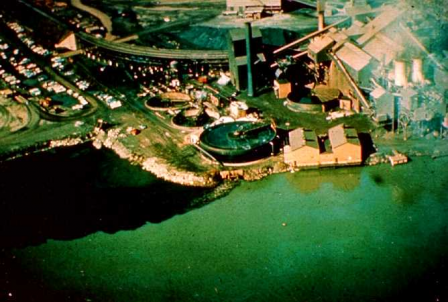 The Black Lagoon (Detroit River AOC) cerca 1961 contaminated with oil and other contaminants of concern. The Black Lagoon was the first Great Lakes Legacy Act sediment remediation project.The Great Lakes Restoration Initiative (GLRI) was launched in 2010 to fast-track efforts to protect and restore the Great Lakes. Accelerating the cleanup of AOCs is a priority under the GLRI. Under the GLRI, USEPA works with other federal agencies, states, tribes, and local communities to develop and implement projects to remove BUIs and delist AOCs. The Great Lakes Legacy Act (GLLA) is the United States' program for accelerating sediment cleanups in AOCs. The GLLA uses a unique, cost-sharing strategy to fund and perform sediment cleanups and associated habitat restoration.
The Black Lagoon (Detroit River AOC) cerca 1961 contaminated with oil and other contaminants of concern. The Black Lagoon was the first Great Lakes Legacy Act sediment remediation project.The Great Lakes Restoration Initiative (GLRI) was launched in 2010 to fast-track efforts to protect and restore the Great Lakes. Accelerating the cleanup of AOCs is a priority under the GLRI. Under the GLRI, USEPA works with other federal agencies, states, tribes, and local communities to develop and implement projects to remove BUIs and delist AOCs. The Great Lakes Legacy Act (GLLA) is the United States' program for accelerating sediment cleanups in AOCs. The GLLA uses a unique, cost-sharing strategy to fund and perform sediment cleanups and associated habitat restoration.
In order to delist an AOC federal, state, tribal and local partners collaborate to:
- develop BUI removal targets
- develop management action lists that will achieve these targets
- implement management actions
- monitor for environmental recovery
- remove BUIs.
All BUIs must be removed before an AOC can begin the delisting process.
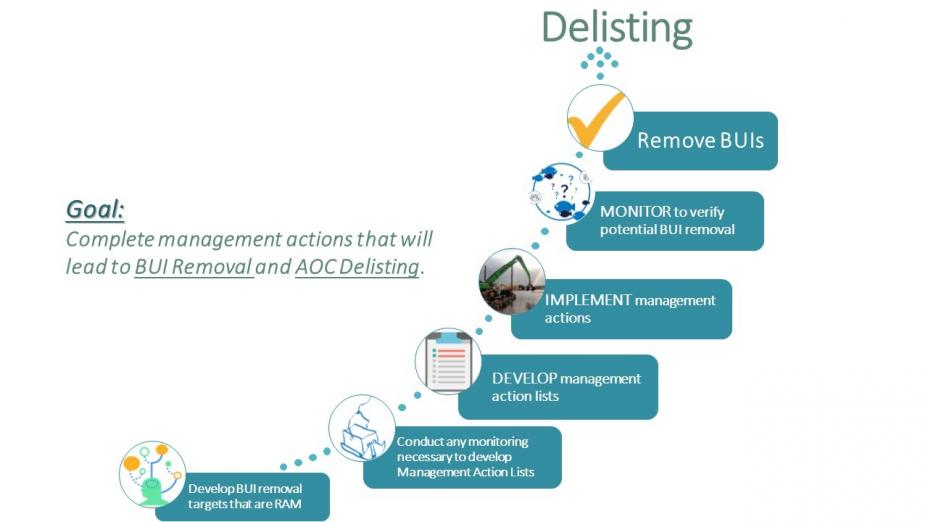 Once an AOC is delisted, the AOC is considered restored to Great Lakes background levels and no additional work will be conducted under the AOC program.
Once an AOC is delisted, the AOC is considered restored to Great Lakes background levels and no additional work will be conducted under the AOC program.
Develop Beneficial Use Impairment Removal Criteria
In order to address BUIs, each state, working with local advisory groups, was tasked with establishing restoration targets that define success for each BUI. USEPA and other federal agencies did not define explicit targets for each BUI. The International Joint Commission (IJC) provided some very broad guidance on targets for each BUI in the early 1990s. However, an EPA guidance document offered these criteria for restoration targets (USPC 2001):
- BUI removal criteria should be realistic, measurable, and achievable.
- Targets should be premised on local goals and related objectives for the watershed; they should be consistent with applicable federal and state regulations, objectives, guidelines, standards and policies, when available, and the principles and objectives embodied in the AOC Annex 1 in the 2012 Great Lakes Water Quality Agreement.
- Targets should be developed and periodically reviewed on a site-specific basis (allowing for flexibility in addressing local conditions) by the respective state agencies in consultation with local stakeholders and other interested parties. This is important because as new information is developed, the states and local communities are encouraged to modify targets to effectively remove the BUIs.
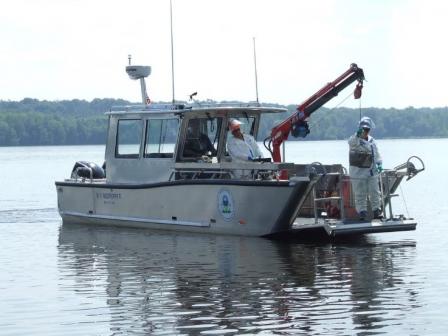 EPA's research vessel, The Mud Puppy, takes sediment samples in order to test sediment contamination levels. Sediment monitoring is necessary to determine necessary sediment remediation projects and after project completion to assure remedial goals have been achieved.
EPA's research vessel, The Mud Puppy, takes sediment samples in order to test sediment contamination levels. Sediment monitoring is necessary to determine necessary sediment remediation projects and after project completion to assure remedial goals have been achieved.
Develop Management Action Lists
For each AOC, a management action list includes all projects necessary to remove the relevant BUIs and, hence, delist the AOC. The predominant actions that need to take place to remove BUIs are sediment remediation and restoration. A management action list may be created for a single BUI or for a set of BUIs. In order to create comprehensive management action list(s), states, working with local partners, conduct necessary monitoring and submit a final list to GLNPO for approval.
Implement Management Actions
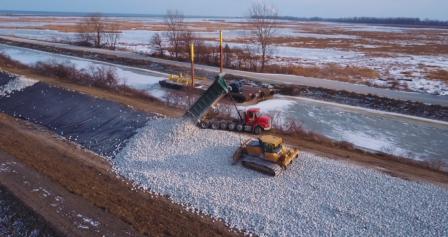 Rock is placed in Howard March (Maumee AOC) to create 1,000 acres of diverse marsh habitat on the shores of Lake Erie. Photo Credit: Toledo Metroparks
Rock is placed in Howard March (Maumee AOC) to create 1,000 acres of diverse marsh habitat on the shores of Lake Erie. Photo Credit: Toledo Metroparks
Through various funding mechanisms under the GLRI, management actions are implemented within AOCs. Management actions are typically sediment remediation or habitat restoration projects, although other types of projects can be incorporated into the management action list(s). Other remedial actions by other programs (Superfund/CERCLA, NRDA, RCRA projects) may also take place within AOCs.
Once all the management actions necessary for removing all BUIs have been completed, the AOC may move into the “Management Actions Complete” phase. These actions may not result in the immediate removal of a set of BUIs, but they are expected to allow environmental conditions to improve over time and lead to eventual BUI removal and AOC delisting.
As of February 2020, nine AOCs have completed all management actions necessary for delisting.
- Ashtabula River
- Waukegan Harbor
- Sheboygan River
- Lower Menominee River
- River Raisin
- St. Clair River
- St. Marys River
- Rochester Embayment
- Manistique River
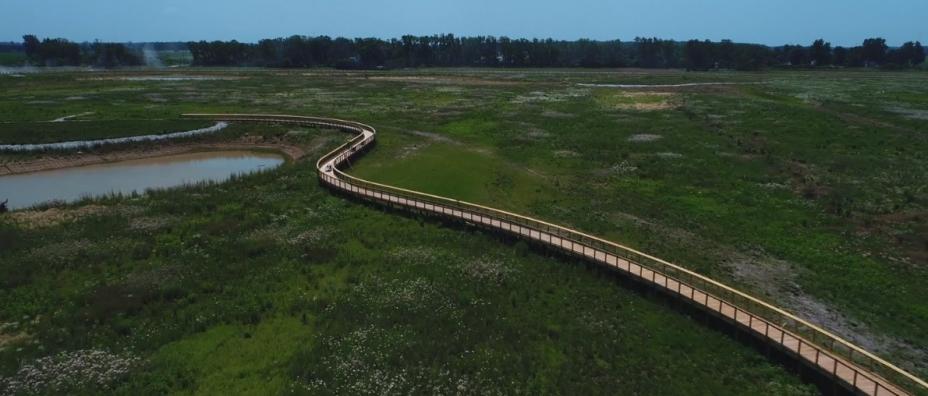 An aerial view of Howard Marsh during construction. This GLRI project is a managment action of the Maumee AOC addressing the Loss of Fish and Wildlife Habitat BUI. Photo Credit: Toledo Metroparks
An aerial view of Howard Marsh during construction. This GLRI project is a managment action of the Maumee AOC addressing the Loss of Fish and Wildlife Habitat BUI. Photo Credit: Toledo Metroparks
Monitoring
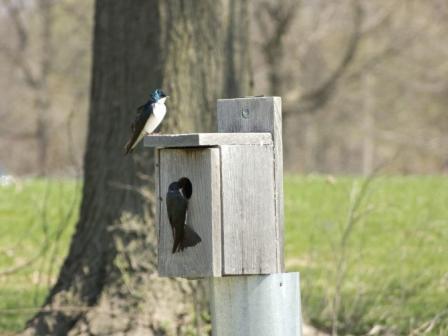 Tree swallows are commonly studied to assess the Bird and Animal Deformities or Reproductive Problems BUI.Data are collected to assess whether BUI restoration targets have been met. Studies may span several years and are a collaboration between federal agencies, State agencies, Tribes, and other partners. Depending on the nature of the BUI, monitoring plans may include one or more of the following activities:
Tree swallows are commonly studied to assess the Bird and Animal Deformities or Reproductive Problems BUI.Data are collected to assess whether BUI restoration targets have been met. Studies may span several years and are a collaboration between federal agencies, State agencies, Tribes, and other partners. Depending on the nature of the BUI, monitoring plans may include one or more of the following activities:
- Field sampling, biological indices, laboratory work, or physical parameters
- Post-construction monitoring
- Surveys, photographs, and citizen science
- Literature review, trend analysis, or statistics
Not all management actions need to be completed in order for monitoring to show BUIs can be removed.
Beneficial Use Impairment Removal
Once monitoring verifies the BUI removal criteria have been met, a BUI can be removed. This requires agreement between the Local Advisory Group and community, the State, and review and approval by USEPA. The USEPA Delisting Guidance document, “Restoring United States Great Lakes Areas of Concern: Delisting Principles and Guidelines”, adopted by the United States Policy Committee (USPC 2001) states the following:
“Re-designation of a BUI from impaired to unimpaired can occur if it can be demonstrated that any or all of the targets below are achieved:
- Approved BUI removal criteria have been met;
- The impairment is not solely of local geographic extent but is typical of upstream conditions OR conditions outside of the AOC boundaries on a regional scale. Such re-designation would be contingent upon evidence that sources within the AOC are controlled;
- The impairment is due to natural rather than human causes.”
There is a total of 255 BUIs for all AOCs. As of February 2020, 90 BUIs have been removed. To understand more about BUIs and the removal process visit Beneficial Use Impairments for the Great Lakes AOCs.
AOC Delisting
Once monitoring has shown that the restoration targets for all BUIs are removed, the State or EPA can initiate the process of formally delisting the AOC. A “Final Delisting Report” will provide the documentation for delisting the AOC and will include: a summary of the remedial measures taken; the status of the beneficial uses; and details on how the delisting criteria have been met.
In 2001, the US Policy Committee for the Great Lakes published Restoring United States Areas of Concern: Delisting Principles and Guidelines, which outlined the steps to delist an AOC. The 2012 Great Lakes Water Quality Agreement (GLWQA) provides new guidance on how to delist an AOC.
As of February 2020, four U.S. based AOCs have been delisted.
Measuring Progress
The GLRI Action Plan defines the course to address pressing Great Lakes environmental problems, such as those in AOCs. The Action Plan also sets targets to show progress in improving environmental conditions. GLRI Action Plan III, which guides GLRI work from 2020 through 2024, identified three measures of success for the AOC program:
- AOCs where all management actions necessary for delisting have been implemented
- Beneficial Use Impairments removed in AOCs
- AOCs with a complete and approved list of all management actions necessary for delisting
